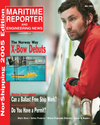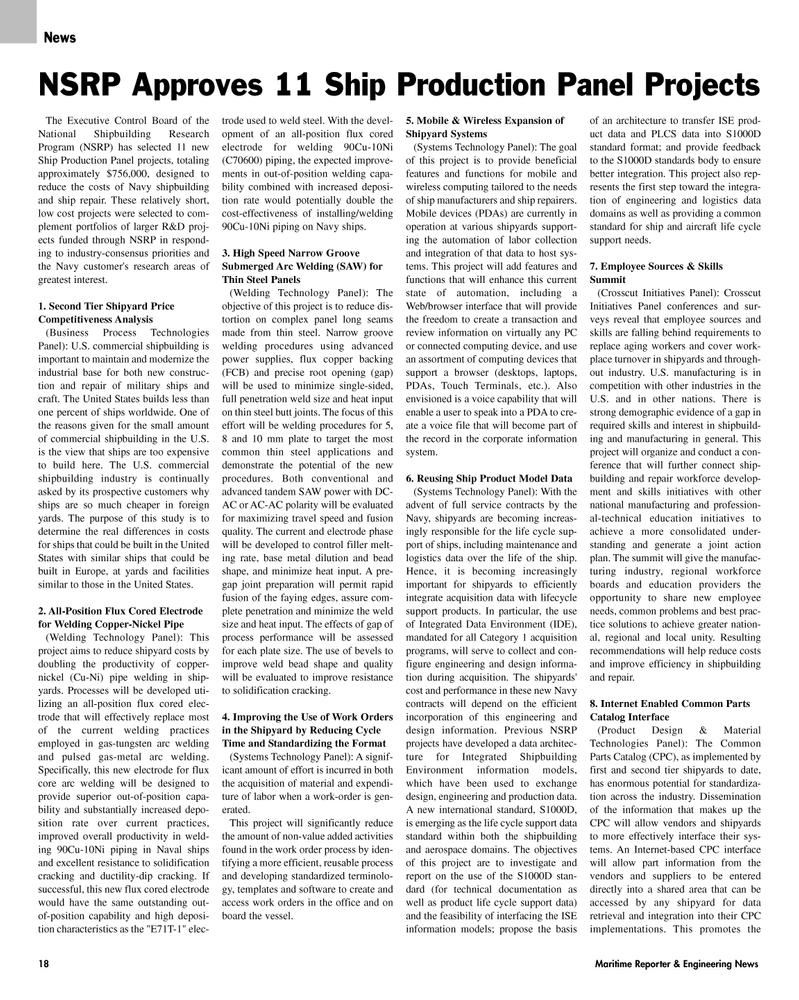
Page 18: of Maritime Reporter Magazine (May 2005)
Marine Enviroment Edition
Read this page in Pdf, Flash or Html5 edition of May 2005 Maritime Reporter Magazine
The Executive Control Board of the
National Shipbuilding Research
Program (NSRP) has selected 11 new
Ship Production Panel projects, totaling approximately $756,000, designed to reduce the costs of Navy shipbuilding and ship repair. These relatively short, low cost projects were selected to com- plement portfolios of larger R&D proj- ects funded through NSRP in respond- ing to industry-consensus priorities and the Navy customer's research areas of greatest interest. 1. Second Tier Shipyard Price
Competitiveness Analysis (Business Process Technologies
Panel): U.S. commercial shipbuilding is important to maintain and modernize the industrial base for both new construc- tion and repair of military ships and craft. The United States builds less than one percent of ships worldwide. One of the reasons given for the small amount of commercial shipbuilding in the U.S. is the view that ships are too expensive to build here. The U.S. commercial shipbuilding industry is continually asked by its prospective customers why ships are so much cheaper in foreign yards. The purpose of this study is to determine the real differences in costs for ships that could be built in the United
States with similar ships that could be built in Europe, at yards and facilities similar to those in the United States. 2. All-Position Flux Cored Electrode for Welding Copper-Nickel Pipe (Welding Technology Panel): This project aims to reduce shipyard costs by doubling the productivity of copper- nickel (Cu-Ni) pipe welding in ship- yards. Processes will be developed uti- lizing an all-position flux cored elec- trode that will effectively replace most of the current welding practices employed in gas-tungsten arc welding and pulsed gas-metal arc welding.
Specifically, this new electrode for flux core arc welding will be designed to provide superior out-of-position capa- bility and substantially increased depo- sition rate over current practices, improved overall productivity in weld- ing 90Cu-10Ni piping in Naval ships and excellent resistance to solidification cracking and ductility-dip cracking. If successful, this new flux cored electrode would have the same outstanding out- of-position capability and high deposi- tion characteristics as the "E71T-1" elec- trode used to weld steel. With the devel- opment of an all-position flux cored electrode for welding 90Cu-10Ni (C70600) piping, the expected improve- ments in out-of-position welding capa- bility combined with increased deposi- tion rate would potentially double the cost-effectiveness of installing/welding 90Cu-10Ni piping on Navy ships. 3. High Speed Narrow Groove
Submerged Arc Welding (SAW) for
Thin Steel Panels (Welding Technology Panel): The objective of this project is to reduce dis- tortion on complex panel long seams made from thin steel. Narrow groove welding procedures using advanced power supplies, flux copper backing (FCB) and precise root opening (gap) will be used to minimize single-sided, full penetration weld size and heat input on thin steel butt joints. The focus of this effort will be welding procedures for 5, 8 and 10 mm plate to target the most common thin steel applications and demonstrate the potential of the new procedures. Both conventional and advanced tandem SAW power with DC-
AC or AC-AC polarity will be evaluated for maximizing travel speed and fusion quality. The current and electrode phase will be developed to control filler melt- ing rate, base metal dilution and bead shape, and minimize heat input. A pre- gap joint preparation will permit rapid fusion of the faying edges, assure com- plete penetration and minimize the weld size and heat input. The effects of gap of process performance will be assessed for each plate size. The use of bevels to improve weld bead shape and quality will be evaluated to improve resistance to solidification cracking. 4. Improving the Use of Work Orders in the Shipyard by Reducing Cycle
Time and Standardizing the Format (Systems Technology Panel): A signif- icant amount of effort is incurred in both the acquisition of material and expendi- ture of labor when a work-order is gen- erated.
This project will significantly reduce the amount of non-value added activities found in the work order process by iden- tifying a more efficient, reusable process and developing standardized terminolo- gy, templates and software to create and access work orders in the office and on board the vessel. 5. Mobile & Wireless Expansion of
Shipyard Systems (Systems Technology Panel): The goal of this project is to provide beneficial features and functions for mobile and wireless computing tailored to the needs of ship manufacturers and ship repairers.
Mobile devices (PDAs) are currently in operation at various shipyards support- ing the automation of labor collection and integration of that data to host sys- tems. This project will add features and functions that will enhance this current state of automation, including a
Web/browser interface that will provide the freedom to create a transaction and review information on virtually any PC or connected computing device, and use an assortment of computing devices that support a browser (desktops, laptops,
PDAs, Touch Terminals, etc.). Also envisioned is a voice capability that will enable a user to speak into a PDA to cre- ate a voice file that will become part of the record in the corporate information system. 6. Reusing Ship Product Model Data (Systems Technology Panel): With the advent of full service contracts by the
Navy, shipyards are becoming increas- ingly responsible for the life cycle sup- port of ships, including maintenance and logistics data over the life of the ship.
Hence, it is becoming increasingly important for shipyards to efficiently integrate acquisition data with lifecycle support products. In particular, the use of Integrated Data Environment (IDE), mandated for all Category 1 acquisition programs, will serve to collect and con- figure engineering and design informa- tion during acquisition. The shipyards' cost and performance in these new Navy contracts will depend on the efficient incorporation of this engineering and design information. Previous NSRP projects have developed a data architec- ture for Integrated Shipbuilding
Environment information models, which have been used to exchange design, engineering and production data.
A new international standard, S1000D, is emerging as the life cycle support data standard within both the shipbuilding and aerospace domains. The objectives of this project are to investigate and report on the use of the S1000D stan- dard (for technical documentation as well as product life cycle support data) and the feasibility of interfacing the ISE information models; propose the basis of an architecture to transfer ISE prod- uct data and PLCS data into S1000D standard format; and provide feedback to the S1000D standards body to ensure better integration. This project also rep- resents the first step toward the integra- tion of engineering and logistics data domains as well as providing a common standard for ship and aircraft life cycle support needs. 7. Employee Sources & Skills
Summit (Crosscut Initiatives Panel): Crosscut
Initiatives Panel conferences and sur- veys reveal that employee sources and skills are falling behind requirements to replace aging workers and cover work- place turnover in shipyards and through- out industry. U.S. manufacturing is in competition with other industries in the
U.S. and in other nations. There is strong demographic evidence of a gap in required skills and interest in shipbuild- ing and manufacturing in general. This project will organize and conduct a con- ference that will further connect ship- building and repair workforce develop- ment and skills initiatives with other national manufacturing and profession- al-technical education initiatives to achieve a more consolidated under- standing and generate a joint action plan. The summit will give the manufac- turing industry, regional workforce boards and education providers the opportunity to share new employee needs, common problems and best prac- tice solutions to achieve greater nation- al, regional and local unity. Resulting recommendations will help reduce costs and improve efficiency in shipbuilding and repair. 8. Internet Enabled Common Parts
Catalog Interface (Product Design & Material
Technologies Panel): The Common
Parts Catalog (CPC), as implemented by first and second tier shipyards to date, has enormous potential for standardiza- tion across the industry. Dissemination of the information that makes up the
CPC will allow vendors and shipyards to more effectively interface their sys- tems. An Internet-based CPC interface will allow part information from the vendors and suppliers to be entered directly into a shared area that can be accessed by any shipyard for data retrieval and integration into their CPC implementations. This promotes the 18 Maritime Reporter & Engineering News
News
NSRP Approves 11 Ship Production Panel Projects
MR MAY 2005 #3 (17-24).qxd 5/2/2005 6:32 PM Page 2

 17
17

 19
19
